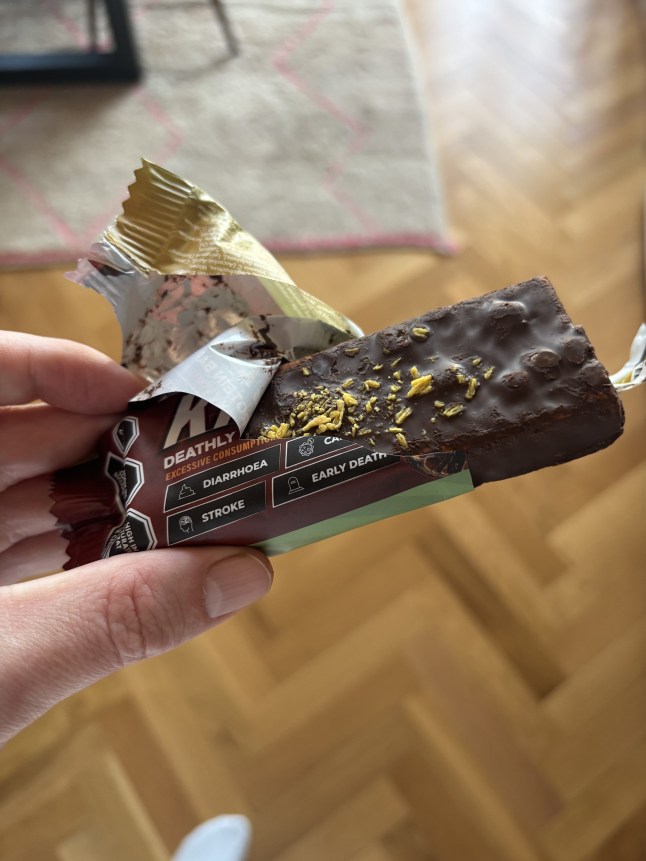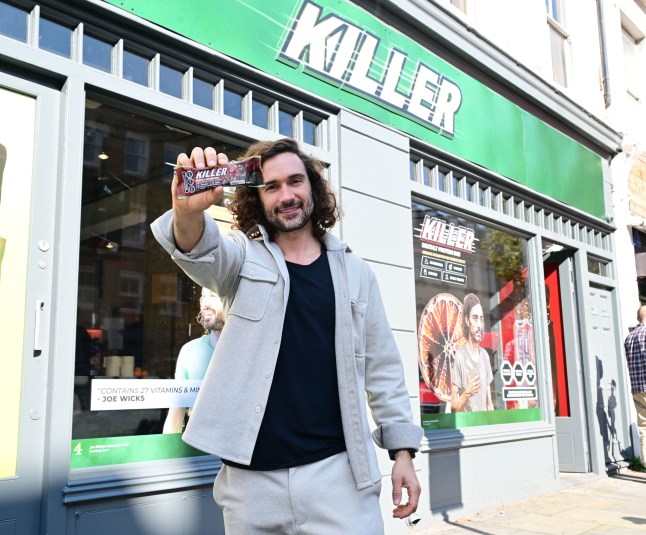
Joe Wicks has launched his first-ever protein bar — but he really doesn’t want you to buy it.
The 40-year-old health guru, known as The Body Coach, became a national treasure after keeping the nation moving during lockdown. His easy teatime recipes have become go-tos for families across the country, and his adoring fans hang on his every word.
He seems like the perfect man to introduce a new protein bar; in fact, it’s a wonder he hasn’t done it before.
The thing is, Joe’s not a fan of the snacks, and in his new show, Licensed to Kill, we learn why.
The Channel 4 Documentary sees Joe create a product packed with chemicals linked to cancer, diabetes, strokes and — at the very least — diarrhoea.
Legally, Joe can make, promote, and sell a product he claims is so harmful, overconsumption could result in hospitalisation or even premature death — and he can still market it as a ‘health’ food.
It’s called Killer — a nod to the gym bros chasing ‘killer abs,’ and a not-so-subtle warning of the potential health consequences of eating ultra-processed foods (UPFs) in excess.
Now, before we go any further, it’s important to note that not all protein bars are dangerous, and not all UPFs are created equal.
Still, as I’m handed a Killer bar after meeting the notoriously friendly personal trainer at the documentary’s screening, I’m nervous.
What are Ultra-processed foods?
‘Ultra-processed foods, or UPFs, are foods that have undergone significant processing and modification from their original state,’ Dr Frankie Phillips, a registered dietitian with the British Dietetic Association, previously told Metro.
‘Some definitions suggest that UPFs usually contain ingredients that aren’t found in a typical kitchen e.g. artificial colours, preservatives, artificial flavours, and emulsifiers.
The review of studies in the British Medical Journal (BMJ) found that high consumption of UPFs is associated with a 50% increased risk of cardiovascular disease-related death, a 48-53% higher risk of mental health issues including anxiety, and a 12% greater risk of type 2 diabetes.
Higher UFP intake was also linked to obesity, a 21% greater risk of death (from any cause), 40-66% greater risk of heart-disease, sleep problems and a 22% more chance of depression.
Processing isn’t all bad
It’s important not to villainise processed foods completely.
As Dr Frankie explained: ‘Processing isn’t all bad, and sometimes it can even help as some nutrients are more easily available to the body when they are processed to some degree.
‘For example, canned tomatoes or tomato puree has more bioavailable antioxidants than a fresh tomato, and life is simply too busy to make everything from scratch all the time.’
I hold off unwrapping the ‘UK’s most dangerous health food’ until I’ve watched the first episode of the series. In it, Joe and Professor Chris van Tulleken develop their first collaboration — a chocolate orange protein bar with 96 ingredients, almost all of them chemical powders and synthetic sludge, apart from cocoa and marmalade.
‘Let’s not pussyfoot around — I want the maximum amount of each harmful ingredient while staying with the legal limit,’ says Joe as he pours additives and sweeteners into the gloopy mix.
They add maltitol, a type of sugar alcohol that doesn’t count as sugar on labelling, so companies can say their product has ‘no added sugar’ or is ‘low sugar’. But it can cause diarrhoea, which I’m not excited about.
There’s also aspartame, a sweetener that has been associated with a higher risk of stroke and cancer, according to the World Health Organisation. Plus maltodextrin, a sweet thickener that lab studies have linked to increases in intestinal inflammation.

With slight trepidation, I take my first bite of Killer. I hate how delicious it is. Even though the texture is intensely chewy and slightly overwhelming, it tastes exactly like a chocolate orange — just a little richer — and, crucially, it’s marketed as much healthier.
Of course, I know it’s not — but many would happily eat one a day, thinking they’re supplementing breakfast or lunch with a nutritious alternative.
Personally, one bite is enough. I can easily demolish a Chocolate Orange in one sitting — two on Christmas Day — but a whole Killer bar would feel like eating an entire supermarket aisle of Easter eggs.
Maybe it’s because I’ve just seen how recklessly it was made, using gunk that could send me to an early grave, but the thought of taking another bite makes me feel sick.
Knowing the full extent of what I’ve just consumed makes me feel genuinely nervous. One bite won’t kill me, of course, but when added to the ultra-processed foods I may be unknowingly eating elsewhere, it certainly doesn’t fill me with confidence.
I’ve never been a ‘protein hound,’ but I have turned to protein shakes and bars on occasion. After watching Licensed to Kill, I won’t be doing that again.
Thankfully, there’s no danger that Killer will spark the next national health crisis — or at least worsen the one we’re already in. Joe is only selling a few thousand bars. He has no interest in becoming a health bar entrepreneur.
Still, Joe’s teaser for the documentary on Instagram, posted shortly after the screening, proves to be controversial. Commenters accuse the PT of vilifying foods, exaggerating the health risks of UPFs, and ignoring the financial barriers to fresh food that many families face.

But the reality is, his bar is only slightly more concerning than some of the ones already lining supermarket shelves across the UK — and those are in high demand. Protein bars are a multibillion-pound industry. Some are made with natural ingredients, some are anything but. It’s currently really, really hard to tell them apart.
When Joe first laid out his plan to ‘poison the nation’ to make a point, I was dubious. But after watching him carefully carry out his provocative mission, I’m more convinced this could be the most important project of his life.
He’s not trying to tell anyone what to eat — but he is urging Parliament to ensure we’re properly informed about what we consume. In Chile, ultra-processed food comes with warning labels, similar to the ones we see on cigarette packets here in the UK. There’s no reason ultra-processed food shouldn’t be treated the same way here.
And as Joe added in an article for The Standard, financially-strapped, time-poor consumers also need more help. ‘The government and supermarkets need to put offers on real food, not just the crap they’re selling at the end of the aisles,’ he said.
Who could argue with that?
Perhaps Joe’s true legacy won’t be just keeping the nation fit during lockdown, but reducing cancer, strokes, diabetes, and premature deaths — all with a simple label on the foods quietly putting us in the ground.
The 96 ingredients in Joe's Killer bar
Professor Chris van Tulleken gave the Daily Mail the full ingredients rundown:
Chocolate protein dough: Protein blend (hydrolysed whey protein (hydrolysed whey protein isolate (milk), sunflower lecithin), hydrolysed collagen, caseinate calcium (milk)) (27%), maltitol syrup, polydextrose, oligofructose, water, fructo-oligosaccharides, hydrogenated palm kernel oil, maltodextrin, cocoa powder (2.2%), multivitamin complex (calcium carbonate, maltodextrin, magnesium oxide, vitamin C (ascorbic acid), citrus bioflavonoids (35% hesperidin), green tea extract (95% polyphenols), choline bitartrate, grape seed extract (95% polyphenols), lutein (marigold flower extract), iron (ferrous sulphate), lycopene (tomato extract), vitamin E (DL-alpha tocopherol acetate), anti-caking agent (silicon dioxide), inositol, quercetin, zinc oxide, niacin (nicotinamide), vitamin D3 preparation (maltodextrin, starch, sucrose, cholecalciferol), coenzyme Q10, pantothenic acid (calcium pantothenate), black pepper extract (95% piperine), vitamin A preparation (maltodextrin, dextrin, modified starch, vitamin A Acetate oil, dl-alpha tocopherol), lactobacillus acidophilus, vitamin K (Phylloquinone), vitamin B6 (pyridoxine HCl), thiamin, riboflavin, manganese sulphate, folic acid, chromium chloride, copper sulphate, selenium (sodium selenite), biotin, vitamin B12 (carboxymethyl cellulose), glycerol, potassium chloride, multivitamin complex (calcium citrate malate granular, buffered magnesium citrate, vitamin C (ascorbic acid), ferrous (iron II) bisglycinate chelate, zinc citrate dihydrate, natural vitamin E (D-alpha tocopheryl acetate), vitamin B3 (nicotinamide), L-selenomethionine, vitamin A acetate (retinol), vitamin B5 (calcium pantothenate), vitamin K2 menaquinone-7 (MK7), manganese sulphate, beta carotene, copper sulphate anhydrous, vitamin B12 (methylcobalamin), vitamin B6 (‘P5P’ pyridoxal-5-phosphate monohydrate), vitamin D2 ergocalciferol, vitamin B2 (riboflavin), vitamin B1 (thiamine HCL), chromium picolinate, vitamin B9 (L-5-MTHF), potassium iodide, sodium molybdate, vitamin B7 (Biotin)), flax seed oil, sweetener: xylitol. Preservative: sodium benzoate, carboxymethyl cellulose, emulsifier: xanthan gum, sunflower lecithin. Sweetener: aspartame, sucralose.
Orange spread: Sugar-free caramel (polydextrose (dietary fibres), sweetener: maltitol syrup, sweetened condensed milk, vegetable fat, stabiliser: glycerol, cocoa butter, emulsifier: sunflower lecithin, salt, stabiliser: pectin, colour: plain caramel (natural flavour), white chocolate coating (sugar, palm oil (palm oil, fully hydrogenated palm oil), whey powder (milk), emulsifier (soya, flavouring], colour: annatto [E160b(ii), maltodextrin], orange oil (1%).
Dark chocolate flavour coating: Dark chocolate (sugar, palm oil, fat-reduced cocoa powder (14%), emulsifier: soya lecithin, polyglycerol polyricinoleate).
Soy crispies: Soya protein isolate, tapioca starch, salt.
Orange crunchies: Orange, sucrose, maize starch (0.3%).
Write Reviews
Leave a Comment
No Comments & Reviews